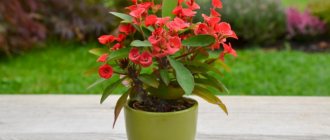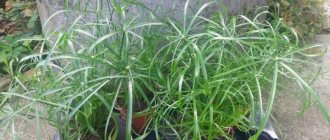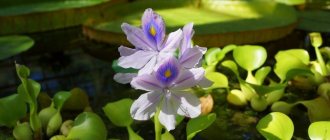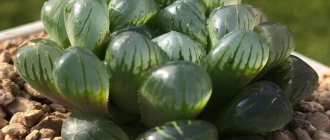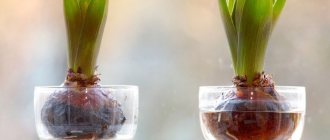Begonia
This beautiful indoor plant, native to the tropical forests of South America and Central Africa, has taken root in many homes. Bush, tuberous, flowering, decorative deciduous and hanging plant species are known. A characteristic feature of begonias is the presence of a clearly visible vein on the surface of the leaf plate, which divides the leaf into two parts. Begonia leaves can be glossy, matte, velvety, with a silver or bronze tint. Most varieties have simple or double buds of various colors.
According to esotericists, begonia is a kind of indicator of the atmosphere in the house. In families where love and mutual understanding reign, the plant delights with lush foliage and abundant flowering. Drying leaves can be a signal of impending trouble. It is generally accepted that begonia with elongated leaves can have a negative impact on the inhabitants of the house.
Indoor plants that should not be placed in the nursery
Any poisonous flowers should not be placed in children's rooms. If there are small children in the house, then parents should take care that the children do not have any contact with the dangerous flower. In general, it is important that the child cannot touch any plant. This will be a reliable prevention of poisoning of the child’s body or injury.
There are also indoor plants that should never be placed in a child’s room.
- Ficus. The plant is very beautiful, it has a lush green crown. But the peculiarity of the ficus is that its milky juice contains toxic substances. A poisonous plant constantly “throws” toxic substances into the air. If the flower is placed in the nursery, and the baby constantly breathes ficus fumes, then the risk of developing a complex allergic reaction will be very high.
- Decorative peppers, indoor nightshade crops. The plants themselves do not pose a danger to the child’s body. But berries that ripen on plants can cause acute poisoning. Children, due to their curiosity, can taste the unripe berries of these crops, which will subsequently lead to sad consequences.
- Dieffenbachia. The indoor tree has a poisonous milky sap. During an accidental or intentional injury, the tree will begin to actively release toxic substances, upon contact with which a child may suffer a burn or poisoning. The situation will be especially dangerous if the milky juice of Dieffenbachia gets into the baby’s respiratory tract or digestive tract. Such a nuisance can even end in death.
- Philodendron. An indoor flower is extremely dangerous. It has similar qualities to Dieffenbachia. Placing a philodendron in a nursery is strictly prohibited.
- Azalea. A beautiful plant releases toxic substances into the atmosphere. This occurs both during the flowering of the plant and during its vegetative growth. Thus, it is not recommended to keep azaleas in the house at all.
Lily
This perennial bulbous plant resembles a daffodil in appearance, and its delicate aroma has jasmine notes. At home, the height of the flower can reach 40–200 cm. The lily has dense flexible petioles on which oval-shaped leaves are located.
With proper care, the lily blooms 2–3 times a year. At this time, several long hollow peduncles up to 80 cm high are formed on the plant, on which 5–8 flowers bloom. The flowers consist of six petals united into a funnel- or bell-shaped corolla. The diameter of one flower can reach 10–12 cm. Flowers are usually united in umbrella inflorescences.
Lily has strong energy, but it should be remembered that its leaves contain toxic substances that can cause poisoning in people and pets.
Many people consider the lily to be a vampire that absorbs energy. It is no coincidence that many plants next to it grow very slowly or die.
Violet
There is a well-known superstition according to which a young girl should not place a violet in her room. If she does this, she will never get married, or she will, but for convenience.
In addition, it is not recommended to keep violets in the house, so as not to expose the girl to diseases of the reproductive system.
Fern
An unpretentious ornamental plant is often grown at home. Ferns are characterized by rapid growth, are undemanding in care, and have an attractive appearance. They have short creeping roots and light green leaf plates, collected in basal rosettes. The leaves can be of various triangular or slightly elongated shapes, with wavy edges.
Moderately dangerous plants
Some of the flowers can be considered moderately dangerous. Even if they contain harmful substances, even if they enter the environment they do not cause serious harm.
They may cause illness, but do not pose a threat to life and health. Still, you should know which flowers should not be kept at home, and why, in order to avoid negative effects, even to a small extent.
Ficus
Information often appears about the dangers of Ficus. According to experts, this is not entirely true. More precisely, ficus is dangerous only for some creatures - cats.
Ficus
The plant does not pose a direct threat to people, because it does not contain toxic substances. But ficus can cause a negative reaction from the body, since it belongs to the group of allergens.
It is better not to grow a plant of this species at home where a cat lives. This is due to the fact that if ficus juice enters the animal’s body, vomiting may occur. The reason is the strong bitterness of the plant liquid.
Fern
Domestic varieties of this plant seem harmless, but they can cause harm, although not too much.
Fern
Experts do not recommend placing a fern in the bedroom, next to the bed. However, this recommendation applies to most indoor plants.
But ferns can have an effect on the body similar to that of lilies: they release carbon dioxide, the excess of which often causes headaches.
Lily
Lily can cause discomfort due to different properties. First of all, the content of a high amount of essential oils is noted. Their concentration is so high that in the evening the smell of lilies can be felt at a distance of more than 10 m.
Lily
If plants exude aroma in a room, it will intensify many times over. This content of essential oils causes headaches.
A similar result can be obtained thanks to the processes occurring in the tissues of the plant - the lily releases carbon dioxide, converting it from oxygen. As a result, your head may hurt.
Orchid
The flower is not dangerous and does not directly harm humans. But it is recommended to grow only certain species at home.
Orchid
It is believed that the orchid is something like an energy vampire - it contributes to the deterioration of well-being.
A person may feel unwell or have a headache for no apparent reason. Some plants emit aroma of varying intensities.
The stronger the smell, the worse your headache may be.
Hydrangea
Hydrangea is classified as moderately poisonous. Causes more harm than fern or orchid: it contains poison - cyanide, but in small concentrations.
Hydrangea
Moreover, it enters the body when consuming flowers and buds. As a result, the functioning of the cardiovascular system may be disrupted, and under the same conditions food poisoning develops.
Loss of consciousness is possible, and convulsions occur.
Dracaena
The flower cannot be called particularly dangerous.
Dracaena
It does not contribute to the development of allergies under normal conditions, but, like any plant, it releases substances during its life, which means that a certain amount of allergens can still enter the air.
There is also a risk of developing an individual reaction when inhaling spores of the fungus that develops in the soil on the leaves, so it is important to provide quality care.
Crassula
It is believed that the money tree harms the energy of the home. But lovers of this plant also know other facts - the fat plant contains arsenic. Moreover, its quantity is significant - a couple of leaves are enough to poison yourself.
Crassula
Vomiting, diarrhea appears, and the person may even lose consciousness. And esotericists talk about the need to compensate for the feminine energy that the money tree carries.
Note: To do this, there must be plants with masculine energy in the house, which will allow you to achieve balance.
Geranium
Geranium is classified as moderately dangerous. It is not recommended to grow it where children, pregnant women, and elderly people live.
Geranium
Geranium is a strong allergen that can cause serious health problems. Also, the composition of plant tissues includes substances that help change the properties of blood.
Geranium affects its thickness. Those who have thrombophlebitis should not consume this plant in any form.
Tuberose
Tuberose, or polyanthes, is a herbaceous perennial native to Central America with an attractive appearance. Tuberose has a tall straight stem and dark green velvety leaves up to 40 cm long, collected at the bottom of the shoot. During the flowering period, up to 40 flowers with dense, pointed petals gradually bloom at the top of the stem. They have a delicate, pleasant aroma that intensifies in the evening.
It is believed that tuberose absorbs other people's energy without giving anything in return. In addition, it provokes scandals in the family and betrayal, so growing it at home is undesirable.
Hibiscus
Hibiscus is called the flower of death because it blooms out of season. This phenomenon indicates an imminent death in the family.
Hibiscus is also not recommended for unmarried ladies, otherwise they will never meet their love. If a girl already has a boyfriend, then soon he may leave her and leave forever.
Hippeastrum
The perennial bulbous plant serves as a real home decoration. The narrow, slightly rough leaves of the plant are arranged in two rows, reaching a length of 70 cm. In the center of each leaf there is a small depression. During the flowering period, the hippeastrum forms a long, powerful peduncle on which large buds bloom. The color of simple or double petals can be different: white, bright red, peach, pink, cream. There may be thin stripes or a border on their surface.
Hippeastrum does not like quarrels and conflicts in the house. The flower absorbs negative energy, giving it back in full later. To avoid a constant influx of negative energy, it is necessary to avoid scandals or get rid of the plant.
Ivy
Magnet of misfortune. It cannot be given to newlyweds - quarrels and discord are guaranteed. And as a result, the man leaves home. Even the teachings of Feng Shui claim that ivy is able to take away all the good energy from the house and takes away health and love.
7 plants best suited for the bedroom
Oleander
Under natural conditions it grows in regions with warm climates, preferring river beds that dry up during the dry season. This evergreen plant has a developed crown formed by strongly branching shoots covered with narrow long leaves on short petioles. The leaf blade is dark green and has a clearly defined central vein. Oleander attracts attention with its beautiful double flowers, collected in loose semi-umbrella inflorescences. The diameter of one flower can reach 8 cm. More often the petals are white, pink, yellow or red.
Positive superstitions about flowers
Folk omens about indoor plants can be both positive and warning. If we talk about the positive, then quite a variety of patterns are recorded between the flower and changes in life.
- Aloe is a protector. Both from unexpected guests and from misfortunes.
- Not sexy enough? Do you want to become more relaxed? Get yourself an avocado.
- Boldness is added when growing balsams at home. But still, it also has “bad” factors. Before you decide to grow this herb, check out its other side.
- Hibiscus, like any rose, attracts fidelity. Love, passion, fidelity - all this will come for the Chinese rose.5. In a house where Dieffenbachia blooms, the air is always clean. but there is a flip side to the coin: they say that male potency suffers greatly from this flower. Failures often happen in bed. As a result, the man feels inadequate and “runs away” from this house.6. There will be no quarrels in a house with dracaena.7. Depression disappears under the influence of jasmine. Helps and “tells” how to get rid of negative thoughts. Feelings are reborn even where only ashes remain. Conflicts do not visit a home with a beautiful flower.8. Brides used to grow such a houseplant as myrtle for their wedding. And then at the wedding itself he gives a branch to each guest. This way she ensures a happy family future for herself.9. Do you want love? Start Oxalis. Helps improve sexual stamina.10. Geranium inspires its owner, helps to survive losses and hardships of life. Destroys all inferiority complexes. But at the same time, it will attract illness and poverty. Does not tolerate Aries and Sagittarius. Pay attention to the smell. He will say a lot about the financial situation of the family. If it “stinks,” then everything is fine. But if the smell is surprisingly pleasant, “not all is well in the Danish kingdom.”
Stellera dwarf
The plant is widespread in the Far East, Siberia and Transbaikalia, preferring mountain slopes and areas with rocky soil.
Stellera has a thick short stem covered with brown bark and developed numerous shoots. The leaves are long, lanceolate, with a pointed crown. The flowers are small, collected in capitate inflorescences located at the tops of the shoots. The petals are white and have a small red spot on the surface.
The rhizome and above-ground parts of the plant contain organic acids that cause numbness and swelling of the vocal cords.
- Author: Inna Kiseleva
Rate this article:
- 5
- 4
- 3
- 2
- 1
(19 votes, average: 3.9 out of 5)
Share with your friends!
What crops can be grown at home?
There are many signs and legends about indoor flowers. And this is not something strange or unusual for knowledgeable gardeners.
For example, in pre-war times, ficus could be found in every home; it was considered the main symbol of prosperity and a happy family life. But after the war it was called the “widow’s flower”, mourning the dead.
Indoor crops that bring money
For financial prosperity, it is recommended to keep flowers at home that attract money and success. There are a sufficient number of varieties of such plants.
Among them is the well-known money tree or Crassula. It can be found in most homes. The oval leaves, falling off, become silvery in color, making them look like coins. If you pinch off a small shoot in the house of rich people and plant it in a red pot, then monetary luck will always accompany you.
There are other flowers, for example:
- fragrant geranium;
- homemade lemon;
- Zamioculcas (dollar tree);
- Dracaena Sandera or bamboo of happiness;
- pachira;
- scindapsus;
- bougainvillea.
Important! Before choosing a flower, make sure that it does not have other signs that do not suit you at all. For example, scindapsus attracts money, but is considered a “husband” flower. Therefore, married people are in danger of being left without a soulmate.
About profitable plants in the video:
Plants that bring family well-being
Many people want to find prosperity in their personal lives or change their marital status, for example, to get married. Therefore, they are advised to purchase flowers for their home that will attract their loved one.
These can be the following plants:
We recommend: Is it possible to keep geraniums in the house? Interpretation of signs and superstitions
- spathiphyllum - a flower of “female happiness”, brings success in love and brings a loved one into the home;
- anthurium – “male happiness”, gives strength and love energy to men in the marital bed;
- oxalis - protects the family from divorce, single people will meet their soulmate;
- calathea - a blooming indoor flower is a symbol of a happy family life; according to popular belief, among quarrels - it dies and withers;
- aichrizon - protects the home from worthless and evil people, with this plant success and good luck come to the house;
- myrtle - an evergreen indoor tree symbolizes strong love for many years, so it can be accepted as a gift, for example, as a gift to newlyweds;
- chlorophytum - refreshes the air in the room and the relationship between lovers who have lost interest in each other;
- violet is a symbol of harmony, mutual understanding and affection.
About flowers that bring happiness to the home in the video:
According to popular superstitions, attracting health
There are plants in nature that can influence human health. They not only decorate the interior of a room, but also enrich the room with oxygen, emit a healing smell, attract health and protect against viruses and bacteria.
What plants to grow on your windowsill:
- aloe and Kalanchoe - seeing flowering promises a quick recovery from a chronic illness;
- geranium - attracts health, luck, well-being in the family, so it is recommended to place a flower pot in the bedroom, children's room or living room;
- hibiscus – has an effect on the cardiovascular system;
- dracaena – normalizes the functioning of the gastrointestinal tract;
- Decembrist - calms the nervous system, normalizes kidney function;
- hydrangea – promotes weight loss and the formation of a beautiful, slender body.


